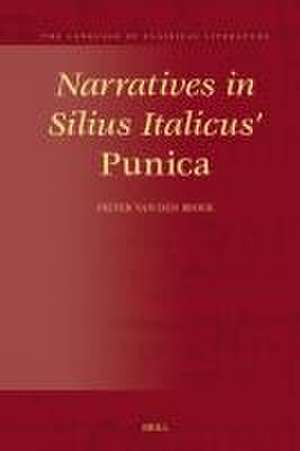Narratives in Silius Italicus’ <i>Punica</i>: The Language of Classical Literature, cartea 38
Autor Pieter Van Den Broeken Limba Engleză Hardback – 14 noi 2023
Preț: 622.65 lei
Preț vechi: 759.33 lei
-18% Nou
Puncte Express: 934
Preț estimativ în valută:
119.15€ • 124.65$ • 98.97£
119.15€ • 124.65$ • 98.97£
Carte indisponibilă temporar
Doresc să fiu notificat când acest titlu va fi disponibil:
Se trimite...
Preluare comenzi: 021 569.72.76
Specificații
ISBN-13: 9789004685826
ISBN-10: 9004685820
Dimensiuni: 155 x 235 mm
Greutate: 0.6 kg
Editura: Brill
Colecția Brill
Seria The Language of Classical Literature
ISBN-10: 9004685820
Dimensiuni: 155 x 235 mm
Greutate: 0.6 kg
Editura: Brill
Colecția Brill
Seria The Language of Classical Literature
Notă biografică
Pieter van den Broek, Ph.D. (2021), University of Amsterdam, is a researcher of Latin poetry from the imperial period. He has published articles on Ovid, Silius Italicus, Statius, and Valerius Flaccus. He teaches classics at the Stedelijk Gymnasium Schiedam.
Cuprins
Acknowledgements
Abbreviations of Editions and Reference Works
Texts and Translations
Introduction
1 Embedded Narratives in the Punica
2 Embedded Narratives and Their Functions
3 Embedded Narratives and Tactics of Delay
4 Embedded Narratives as mise en Abyme: The Example of Proteus
5 Theory and Method
6 Scope of This Study
7 Relevance of This Study
1 An Ambiguous Oracle from the Libyan Desert
1 In the Footsteps of Alexander
2 Synopsis of the Narrative
3 Narratological Structure
4 Intertextuality
5 The Function of the Narrative in the Punica
6 Conclusion
2 Regulus: an Exemplary Hero?
1 Introduction
2 Synopsis of the Narrative
3 Narratology
4 Marus as a Host
5 Exemplarity as Medicine?
6 Learning from the Past?
7 Marus’ First Narrative: The Fight with the Snake
8 Marus’ Second Narrative: The Defeat of Regulus
9 Conclusion
3 A Peaceful Theoxeny amidst Hannibal’s Fury
1 Introduction
2 A New Beginning
3 A Georgic World
4 The Story of Falernus as an Ideal Theoxeny
5 Lucanian Echoes
6 Falernus Overcome by Bacchus
7 Foaming Cups: Intra- and Intertextual Ramifications
8 The Falernus Episode and Hannibal’s Downfall
9 Bacchus as an Unstable Exemplar in the Punica
10 Conclusion
4 Anna and the Paradox of Cannae
1 Introduction
2 Juno’s Intervention in the War
3 Anna and Juturna
4 The Prooemium to the Narrative
5 Dido’s Death
6 Anna’s Stay at Cyrene
7 Sea Storm and Arrival in Latium
8 Anna Meets Aeneas
9 First Narrative of Anna: Dido’s Demise
10 Aeneas’ Narrative
11 Anna’s Second Narrative
12 Dido’s Final Words
13 Anna Tries to Become Dido (but Fails)
14 Reconciliation Prevented
15 Anna Decides to Flee
16 Anna’s Incitation of Hannibal
17 Hannibal’s Response
18 Conclusion
Conclusion
1 Embedded Narratives as Reflections of the Whole
2 Value of Combined Methodology
3 Narrative of Bostar
4 Narrative of Regulus
5 Narrative of Falernus
6 Narrative of Anna Perenna
7 Envoi
Bibliography
Index
Abbreviations of Editions and Reference Works
Texts and Translations
Introduction
1 Embedded Narratives in the Punica
2 Embedded Narratives and Their Functions
3 Embedded Narratives and Tactics of Delay
4 Embedded Narratives as mise en Abyme: The Example of Proteus
5 Theory and Method
6 Scope of This Study
7 Relevance of This Study
1 An Ambiguous Oracle from the Libyan Desert
1 In the Footsteps of Alexander
2 Synopsis of the Narrative
3 Narratological Structure
4 Intertextuality
5 The Function of the Narrative in the Punica
6 Conclusion
2 Regulus: an Exemplary Hero?
1 Introduction
2 Synopsis of the Narrative
3 Narratology
4 Marus as a Host
5 Exemplarity as Medicine?
6 Learning from the Past?
7 Marus’ First Narrative: The Fight with the Snake
8 Marus’ Second Narrative: The Defeat of Regulus
9 Conclusion
3 A Peaceful Theoxeny amidst Hannibal’s Fury
1 Introduction
2 A New Beginning
3 A Georgic World
4 The Story of Falernus as an Ideal Theoxeny
5 Lucanian Echoes
6 Falernus Overcome by Bacchus
7 Foaming Cups: Intra- and Intertextual Ramifications
8 The Falernus Episode and Hannibal’s Downfall
9 Bacchus as an Unstable Exemplar in the Punica
10 Conclusion
4 Anna and the Paradox of Cannae
1 Introduction
2 Juno’s Intervention in the War
3 Anna and Juturna
4 The Prooemium to the Narrative
5 Dido’s Death
6 Anna’s Stay at Cyrene
7 Sea Storm and Arrival in Latium
8 Anna Meets Aeneas
9 First Narrative of Anna: Dido’s Demise
10 Aeneas’ Narrative
11 Anna’s Second Narrative
12 Dido’s Final Words
13 Anna Tries to Become Dido (but Fails)
14 Reconciliation Prevented
15 Anna Decides to Flee
16 Anna’s Incitation of Hannibal
17 Hannibal’s Response
18 Conclusion
Conclusion
1 Embedded Narratives as Reflections of the Whole
2 Value of Combined Methodology
3 Narrative of Bostar
4 Narrative of Regulus
5 Narrative of Falernus
6 Narrative of Anna Perenna
7 Envoi
Bibliography
Index






